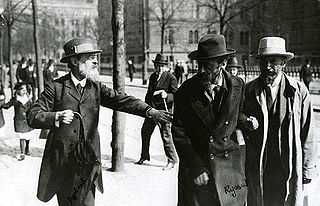Russian Social Democratic Labour Party (Mensheviks)
- This article is about the Mensheviks as an independent political party. For the history of the Menshevik movement as a faction inside the Russian Social Democratic Labour Party, see Menshevik.
| Russian Social Democratic Labour Party (Mensheviks) | |
|---|---|
| Российская социал-демократическая рабочая партия (меньшевиков) | |
| General Secretary | Various |
| Founded | January 1, 1912 |
| Dissolved | 1965 |
| Split from | Russian Social Democratic Labour Party |
| Headquarters |
Saint Peterburg (1912–17) Berlin (1917–33) Paris (1933–40) New York City (1940–65) |
| Newspaper | Sotsialisticheskii vestnik |
| Ideology |
Democratic socialism Orthodox Marxism Agrarianism |
| Political position | Left-wing |
| International affiliation |
Vienna International (1921–23) Labour and Socialist International (1923–40) |
| Colours | Red |
|
Politics of Russia Political parties Elections | |
The Russian Social Democratic Labour Party (Mensheviks) (Russian: Российская социал-демократическая рабочая партия (меньшевиков)) was a political party in Russia. It emerged in 1912, as the Russian Social Democratic Labour Party was divided into two (the other group being the Russian Social Democratic Labour Party (Bolsheviks)). The Mensheviks and Bolsheviks had, however, existed as factions of the original party since 1903.[1]
History

After the 1912 split, the General Jewish Labour Bund in Lithuania, Poland and Russia became a federated part of the Russian Social Democratic Labour Party (Menshevik) (by this time the Mensheviks had accepted the idea of a federated party organization).[2]
At the 1917 congress of the Russian Social Democratic Labour Party (Menshevik) a party Central Committee was elected, consisting of Raphael Abramovich, I. Akhmatov, I. Astrov, Pavel Axelrod, B. Gurevich, E. Broido, F. Lipkin, Fyodor Dan, Henryk Ehrlich, V. Ezhov, K. G. Gogua, B. Gorev, Ivan Maisky, Julius Martov, Alexander Martinov, A. Frumson, Pinkevich, S. Semkovskii and I. Volkov.[3]
After the October Revolution, differences emerged inside the party. In 1921 the party issued the 'Platform of the Russian Social Democratic Labour Party', calling for liquidating the political monopoly of the Communist Party, which was identified as something quite different from the dictatorship of the proletariat, privatizations of large sectors of industry and giving full voting rights to the peasantry and those treated by the Soviet government as the bourgeois class. From the beginning of 1921, after the suppression of the Kronstadt garrison revolt, the 10th Communist Party congress and the introduction of the NEP and ending of forcible confiscation of grain from the peasantry, the Russian Social Democratic Labour Party was forced to operate underground in the Soviet Russia and Soviet Union, and openly only in exile in Europe and North America. The Foreign Delegation of the party had been established in 1920, and was at first located in Berlin (until 1933), then shifted to Paris and in 1940 moved to New York.[4] In exile the party consisted of small groups in Geneva, Liège, Berlin, Paris, Bern and (later) New York.[1]
Martov and Abrahamovich chaired the Foreign Delegation until 1923, from 1923 it was chaired by Fyodor Dan and Abrahamovich. Aron Jugov was the secretary of the Foreign Delegation.[1]
In 1921 the party formed part of the Vienna International, Martov and Abrahamovich being two of the organizers of the International. At the founding congress of the Labour and Socialist International in 1923, eleven Menshevik delegates participated. The party was a member of the Labour and Socialist International 1923-1940.[1] Abramovich represented the party in the LSI executive during this entire period, being a member of the LSI bureau until May 1939.[5]
The party published Sotsialisticheskii vestnik (Socialist Courier) from 1921-1965, from February 1, 1921 to 1933 in Berlin, then in Paris until 1940 and in New York from then until 1965.[1]
References
- ↑ 1.0 1.1 1.2 1.3 1.4 Kowalski, Werner. Geschichte der sozialistischen arbeiter-internationale: 1923 - 19. Berlin: Dt. Verl. d. Wissenschaften, 1985. pp. 336-337
- ↑ Johnpoll, Bernard K. The Politics of Futility; The General Jewish Workers Bund of Poland, 1917-1943. Ithaca, N.Y.: Cornell University Press, 1967. p. 35
- ↑ Brovkin, Vladimir. N. (1991). The Mensheviks after October: socialist opposition and the rise of the Bolshevik dictatorship. Ithaca: Cornell University Press. p. 302. ISBN 978-0-8014-9976-0. Retrieved 2009-11-10.
- ↑ Liebich, André: From the other shore: Russian social democracy after 1921. Cambridge, Mass., London 1997
- ↑ Kowalski, Werner. Geschichte der sozialistischen arbeiter-internationale: 1923 - 19. Berlin: Dt. Verl. d. Wissenschaften, 1985. p. 294